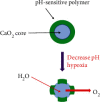Recent Research on Methods to Improve Tumor Hypoxia Environment
- PMID: 33343807
- PMCID: PMC7725563
- DOI: 10.1155/2020/5721258
Recent Research on Methods to Improve Tumor Hypoxia Environment
Abstract
Cancer is a major disease burden worldwide. In recent years, in addition to surgical resection, radiotherapy and chemotherapy are recognized as the most effective methods for treating solid tumors. These methods have been introduced to treat tumors of different origins and stages clinically. However, due to insufficient blood flow and oxygen (O2) supply in solid tumors, hypoxia is caused, leading to decreased sensitivity of tumor cells and poor therapeutic effects. In addition, hypoxia will also lead to resistance to most anticancer drugs, accelerate malignant progress, and increase metastasis. In solid tumors, adequate O2 supply and adequate delivery of anticancer drugs are essential to improve radiotherapy and chemotherapy sensitivity. In recent decades, the researches on relieving tumor hypoxia have attracted researchers' extensive attention and achieved good results. However, as far as we know, there is no detailed review of the researches on alleviating tumor hypoxia. Therefore, in this contribution, we hope to give an overview of the researches on methods to improve tumor hypoxia environment and summarize their effect and application in tumor therapy, to provide a methodological reference for the research and development of new antitumor agents.
Copyright © 2020 Xiao-Hua Zhu et al.
Conflict of interest statement
The authors declare that there is no conflict of interest regarding the publication of this paper.
Figures



Similar articles
-
Recent Advances in Nanoplatform Construction Strategy for Alleviating Tumor Hypoxia.Adv Healthc Mater. 2023 Aug;12(21):e2300089. doi: 10.1002/adhm.202300089. Epub 2023 May 1. Adv Healthc Mater. 2023. PMID: 37055912 Review.
-
Modulating Hypoxia via Nanomaterials Chemistry for Efficient Treatment of Solid Tumors.Acc Chem Res. 2018 Oct 16;51(10):2502-2511. doi: 10.1021/acs.accounts.8b00214. Epub 2018 Sep 20. Acc Chem Res. 2018. PMID: 30234960
-
Inhibiting Hypoxia and Chemotherapy-Induced Cancer Cell Metastasis under a Valid Therapeutic Effect by an Assistance of Biomimetic Oxygen Delivery.Mol Pharm. 2019 Nov 4;16(11):4530-4541. doi: 10.1021/acs.molpharmaceut.9b00663. Epub 2019 Oct 25. Mol Pharm. 2019. PMID: 31617723
-
Hypoxia-modulatory nanomaterials to relieve tumor hypoxic microenvironment and enhance immunotherapy: Where do we stand?Acta Biomater. 2021 Apr 15;125:1-28. doi: 10.1016/j.actbio.2021.02.030. Epub 2021 Feb 24. Acta Biomater. 2021. PMID: 33639310 Review.
-
Assessment of hypoxia by pimonidazole staining following radiotherapy.Methods Cell Biol. 2022;172:179-189. doi: 10.1016/bs.mcb.2022.07.002. Epub 2022 Aug 11. Methods Cell Biol. 2022. PMID: 36064224
Cited by
-
Recombinant ferritins for multimodal nanomedicine.J Enzyme Inhib Med Chem. 2023 Dec;38(1):2219868. doi: 10.1080/14756366.2023.2219868. J Enzyme Inhib Med Chem. 2023. PMID: 37263586 Free PMC article. Review.
-
Biomimetic liposomal nanozymes improve breast cancer chemotherapy with enhanced penetration and alleviated hypoxia.J Nanobiotechnology. 2023 Apr 10;21(1):123. doi: 10.1186/s12951-023-01874-7. J Nanobiotechnology. 2023. PMID: 37038165 Free PMC article.
-
Hypoxia-activated oxidative stress mediates SHP2/PI3K signaling pathway to promote hepatocellular carcinoma growth and metastasis.Sci Rep. 2025 Feb 10;15(1):4847. doi: 10.1038/s41598-025-89137-3. Sci Rep. 2025. PMID: 39924531 Free PMC article.
-
HIF-1α-Mediated Disruption of Cellular Junctions: The Impact of Hypoxia on the Tumor Microenvironment and Invasion.Int J Mol Sci. 2025 May 26;26(11):5101. doi: 10.3390/ijms26115101. Int J Mol Sci. 2025. PMID: 40507913 Free PMC article. Review.
-
Hypoxia-induced cancer cell reprogramming: a review on how cancer stem cells arise.Front Oncol. 2023 Aug 8;13:1227884. doi: 10.3389/fonc.2023.1227884. eCollection 2023. Front Oncol. 2023. PMID: 37614497 Free PMC article. Review.
References
-
- Siegel R. L., Miller K. D., Jemal A. Cancer statistics, 2019. CA: A Cancer Journal for Clinicians. 2018;69(1):7–34. - PubMed
Publication types
MeSH terms
Substances
LinkOut - more resources
Full Text Sources
Medical

